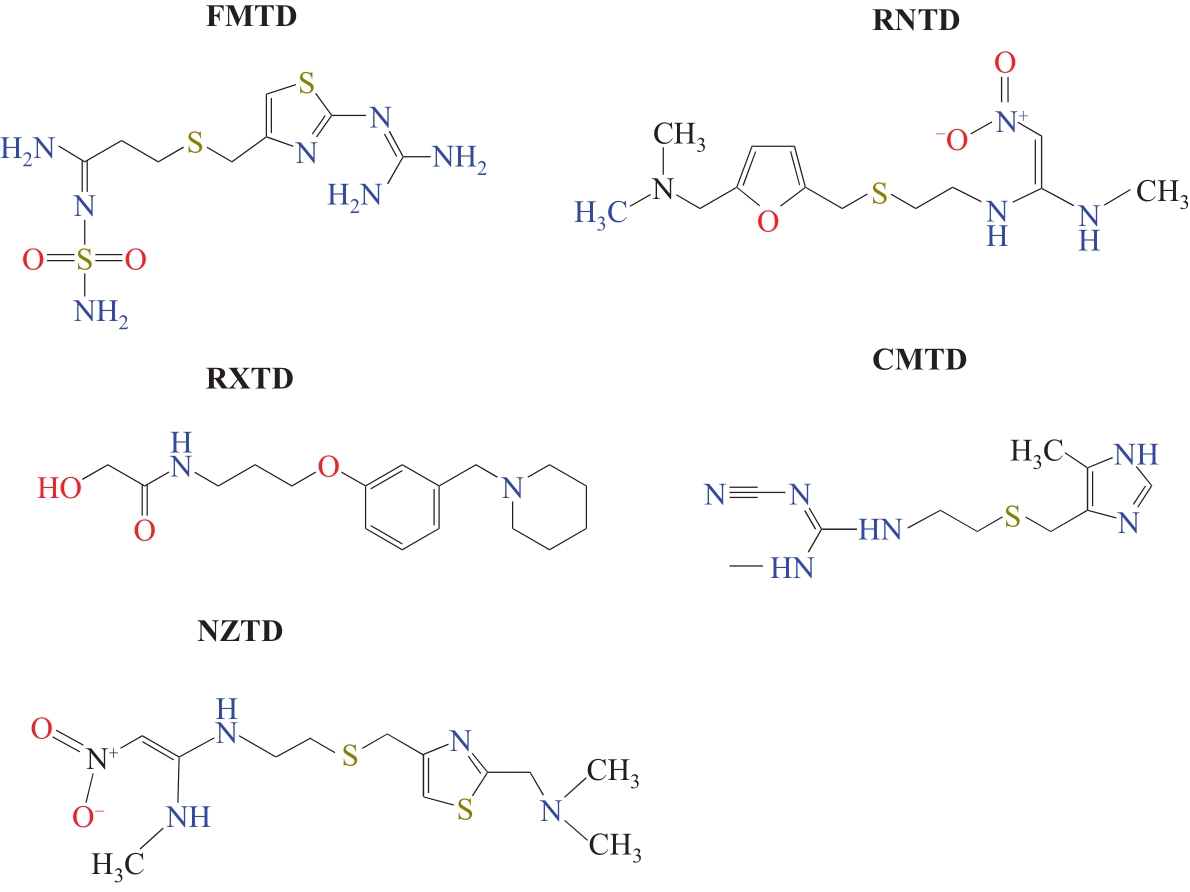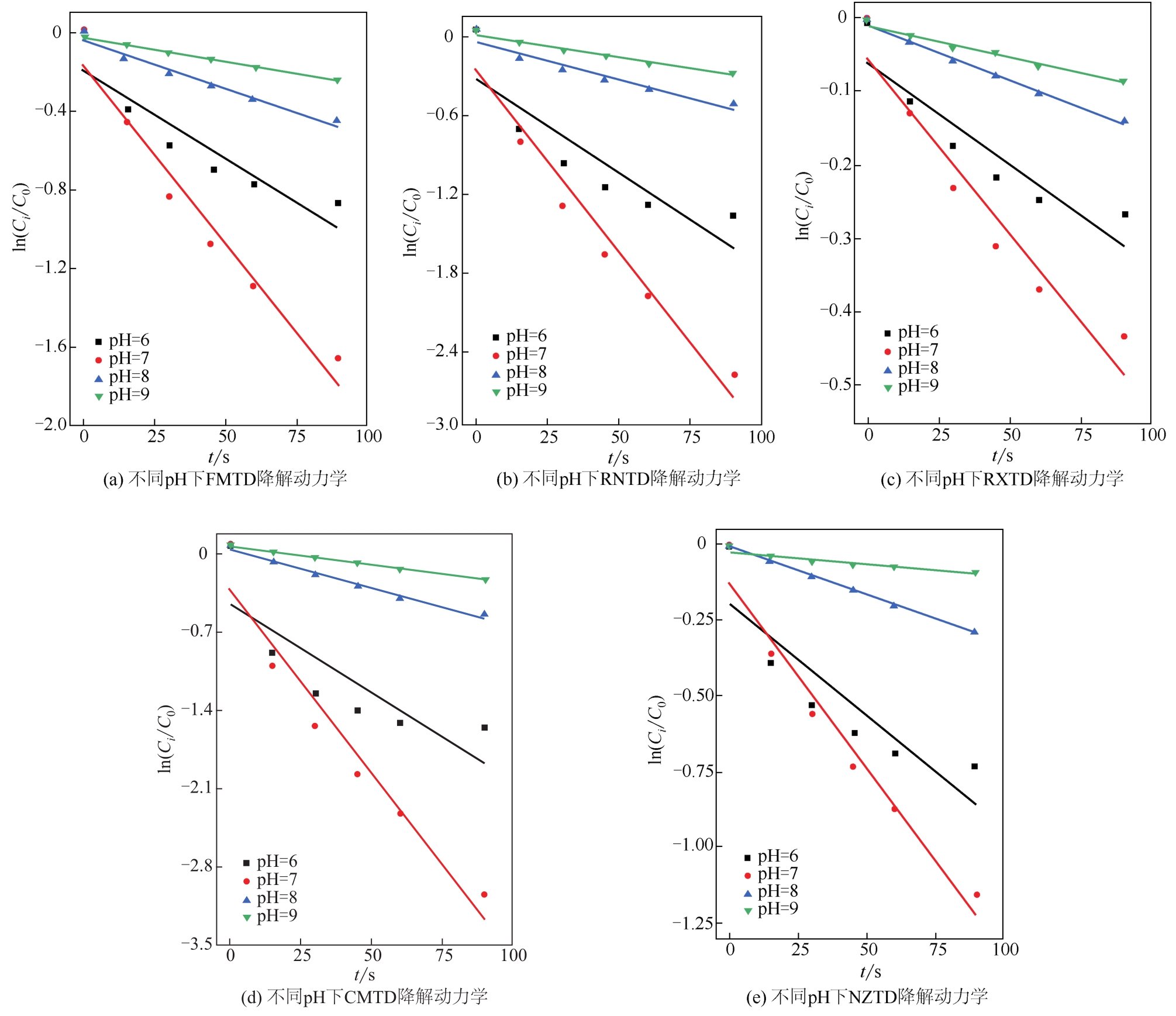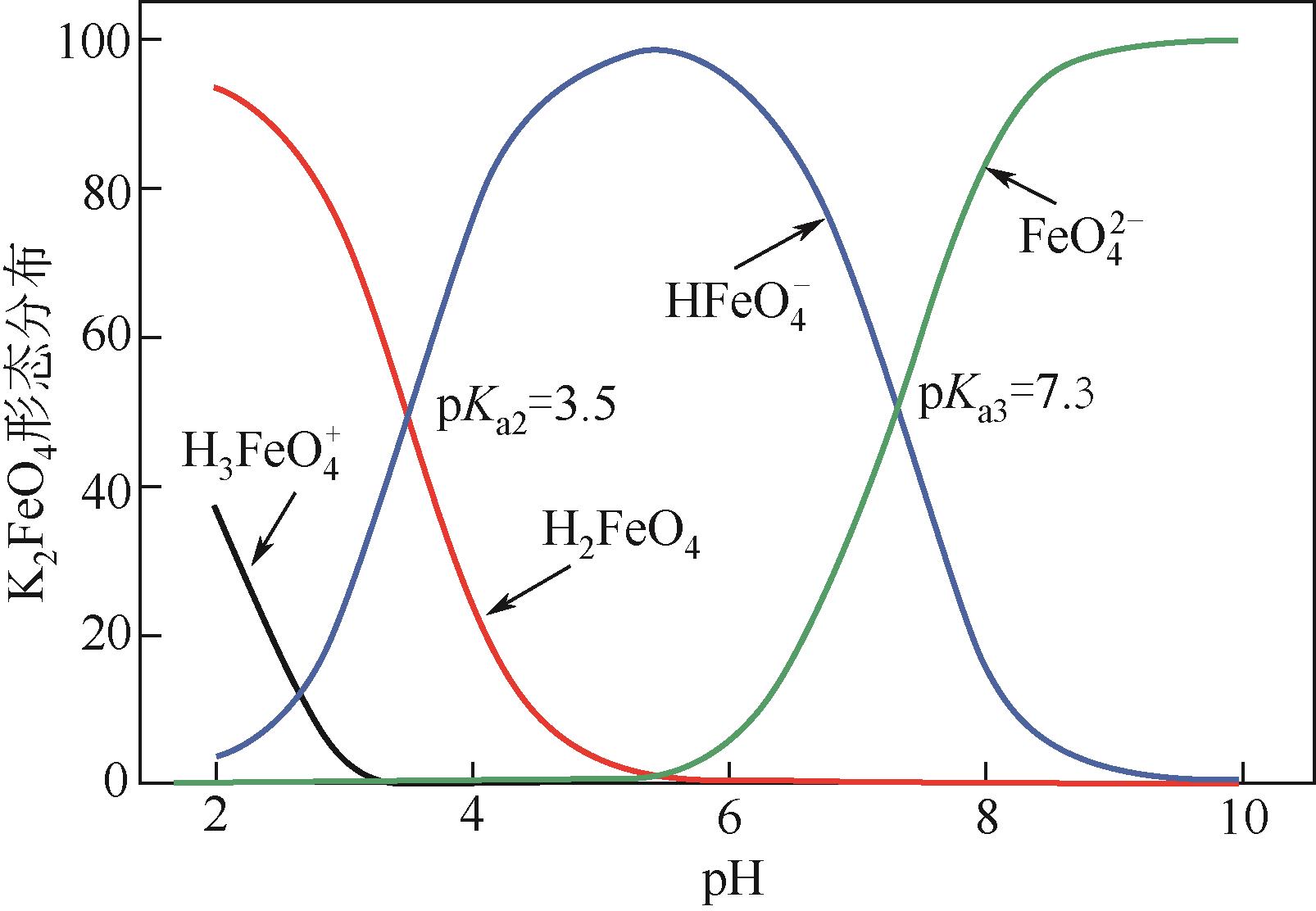Chemical Industry and Engineering Progress ›› 2021, Vol. 40 ›› Issue (8): 4647-4655.DOI: 10.16085/j.issn.1000-6613.2020-1846
• Resources and environmental engineering • Previous Articles Next Articles
Performance and properties of H2-receptor antagonist degradation by ferrate
FANG Zhihuang( ), LIU Xiang, YU Yang, QIAN Yajie(
), LIU Xiang, YU Yang, QIAN Yajie( ), XUE Gang
), XUE Gang
- College of Environmental Science and Engineering, Donghua University, Shanghai 201620, China
-
Received:2020-09-14Online:2021-08-12Published:2021-08-05 -
Contact:QIAN Yajie
高铁酸盐对水中H2受体拮抗剂的降解特性
- 东华大学环境科学与工程学院,上海 201620
-
通讯作者:钱雅洁 -
作者简介:方智煌(1995—),男,硕士研究生,研究方向为水污染控制理论与技术。E-mail:15980235762@163.com 。 -
基金资助:国家自然科学基金青年基金(51708097);国家重点研发计划(2019YFD1100502)
CLC Number:
Cite this article
FANG Zhihuang, LIU Xiang, YU Yang, QIAN Yajie, XUE Gang. Performance and properties of H2-receptor antagonist degradation by ferrate[J]. Chemical Industry and Engineering Progress, 2021, 40(8): 4647-4655.
方智煌, 刘祥, 余阳, 钱雅洁, 薛罡. 高铁酸盐对水中H2受体拮抗剂的降解特性[J]. 化工进展, 2021, 40(8): 4647-4655.
share this article
Add to citation manager EndNote|Ris|BibTeX
URL: https://hgjz.cip.com.cn/EN/10.16085/j.issn.1000-6613.2020-1846
| 水样 | pH | DOC/mg?L-1 | HCO3-/mg?L-1 | Cl-/mg?L-1 |
|---|---|---|---|---|
二沉池出水 地表水 | 7.71 7.23 | 15.6 2.45 | 40.1 87.5 | 71.3 25.6 |
| 水样 | pH | DOC/mg?L-1 | HCO3-/mg?L-1 | Cl-/mg?L-1 |
|---|---|---|---|---|
二沉池出水 地表水 | 7.71 7.23 | 15.6 2.45 | 40.1 87.5 | 71.3 25.6 |
| 组分 | 质量浓度/mg?L-1 | 物质的量浓度/mmol?L-1 | pH |
|---|---|---|---|
NaCl NH4Cl Na2SO4 KCl KH2PO4 CaCl2-2H2O 尿素 | 2925 50 100.5 100 50 50 1260 | 51.3 0.94 0.71 1.34 0.37 0.34 21 | 6.5 6.5 6.5 6.5 6.5 6.5 6.5 |
| 组分 | 质量浓度/mg?L-1 | 物质的量浓度/mmol?L-1 | pH |
|---|---|---|---|
NaCl NH4Cl Na2SO4 KCl KH2PO4 CaCl2-2H2O 尿素 | 2925 50 100.5 100 50 50 1260 | 51.3 0.94 0.71 1.34 0.37 0.34 21 | 6.5 6.5 6.5 6.5 6.5 6.5 6.5 |
| 1 | WU Shou-Mei, Yu-Hsiang HO, WU Hsin-Lung, et al. Head-column field-amplified sample stacking in capillary electrophoresis for the determination of cimetidine, famotidine, nizatidine, and ranitidine-HCl in plasma[J]. Electrophoresis, 2001, 70(3): 540-548. |
| 2 | RADJENOVIĆ J, PETROVIĆ M, BARCELÓ D. Fate and distribution of pharmaceuticals in wastewater and sewage sludge of the conventional activated sludge (CAS) and advanced membrane bioreactor (MBR) treatment[J]. Water Research, 2008, 43(3): 831-841. |
| 3 | CASTIGLIONI S, BAGNATI R, FANELLI R, et al. Removal of pharmaceuticals in sewage treatment plants in Italy[J]. Environmental Science & Technology, 2006, 40(1): 357-363. |
| 4 | 张翠锋, 谢海棠, 潘国宇. 大分子药物的吸收、分布、代谢、排泄和毒性特征及药代模型的应用[J]. 药学学报, 2016, 51(8): 1202-1208. |
| ZHANG Cuifeng, XIE Haitang, PAN Guoyu. The absorption, distribution, metabolism, excretion and toxicity characteristics of macromolecular drugs and the application of pharmacokinetic models [J]. Acta Pharmaceutica, 2016, 51(8): 1202-1208. | |
| 5 | KOLPIN D W, FURLONG E T, MEYER M T, et al. Pharmaceuticals, hormones, and other organic wastewater contaminants in U. S. streams, 1999—2000: a national reconnaissance[J]. Environmental Science & Technology, 2002, 36(6): 1202-1211. |
| 6 | DONG Huiyu, QIANG Zhimin, LIAN Junfeng. Degradation of nitro-based pharmaceuticals by UV photolysis: kinetics and simultaneous reduction on halonitromethanes formation potential[J]. Water Research, 2017, 119: 83-90. |
| 7 | WANG Xiaofeng, ZHOU Beihai, SHAO Xia. Determination of acid dissociation constants and reaction kinetics of dimethylamine-based PPCPs with O3, NaClO, ClO2 and KMnO4[J]. Journal of Environmental Science and Health A, 2019, 54(6): 518-525. |
| 8 | KEANE D, BASHA S, NOLAN K, et al. Photodegradation of famotidine by integrated photocatalytic adsorbent (IPCA) and kinetic study[J]. Catalysis Letters, 2010, 141(2): 300-308. |
| 9 | KARPIŃSKA J, SOKÓŁ A, KOBESZKO M, et al. Study on degradation process of famotidine hydrochloride in aqueous samples[J]. Toxicological & Environmental Chemistry, 2010, 92(8): 1409-1422. |
| 10 | HOPPE P D, ROSI-MARSHALL E J, BECHTOLD H A. The antihistamine cimetidine alters invertebrate growth and population dynamics in artificial streams[J]. Freshwater Science, 2012, 31(2): 379-388. |
| 11 | JIANG Jiaqian. Advances in the development and application of ferrate(Ⅵ) for water and wastewater treatment[J]. Journal of Chemical Technology & Biotechnology, 2014, 89(2): 165-177. |
| 12 | WANG Yingling, LIU Haijin, LIU Guoguang, et al. Oxidation of diclofenac by potassium ferrate(Ⅵ): reaction kinetics and toxicity evaluation[J]. Science of the Total Environment, 2014, 506/507: 252-258. |
| 13 | SHARMA V K, LUTHER G W, MILLERO F J. Mechanisms of oxidation of organosulfur compounds by ferrate(Ⅵ) [J]. Chemosphere, 2011, 82(8): 1083-1089. |
| 14 | SHARMA V K, LIU Fei, TOLAN S, et al. Oxidation of β-lactam antibiotics by ferrate(Ⅵ) [J]. Chemical Engineering Journal, 2013, 221: 446-451. |
| 15 | GOMBOS E, BARKÁCS K, FELFÖLDI T, et al. Removal of organic matters in wastewater treatment by ferrate(Ⅵ)-technology[J]. Microchemical Journal, 2013, 107: 115-120. |
| 16 | QIAN Yajie, HUANG Jinjing, LIU Xiang, et al. Rapid oxidation of histamine H2-receptor antagonists by peroxymonosulfate during water treatment: kinetics, products, and toxicity evaluation[J]. Water Research, 2020, 185: 116278 |
| 17 |
AN Jibin, XIA Chunqiu, HE Jiahong, et al. Oxidation of propyl paraben by ferrate( ): kinetics, products, and toxicity assessment[J]. Journal of Environmental Science and Health A, 2018, 53(10): 873-882. ): kinetics, products, and toxicity assessment[J]. Journal of Environmental Science and Health A, 2018, 53(10): 873-882.
|
| 18 |
KAMACHI T, KOUNO T, YOSHIZAWA K. Participation of multioxidants in the pH dependence of the reactivity of ferrate( ) [J]. The Journal of Organic Chemistry, 2005, 70(11): 4380-4388. ) [J]. The Journal of Organic Chemistry, 2005, 70(11): 4380-4388.
|
| 19 |
SHARMA V K, CABELLI D E. Reduction of oxyiron( ) by sulfite and thiosulfate in aqueous solution[J]. The Journal of Physical Chemistry A, 2009, 113(31): 8901-8906. ) by sulfite and thiosulfate in aqueous solution[J]. The Journal of Physical Chemistry A, 2009, 113(31): 8901-8906.
|
| 20 |
SHARMA V K, SMITH J O, MILLERO F J. Ferrate( ) oxidation of hydrogen sulfide[J] . Environmental Science & Technology, 1997, 31(9): 2486-2491. ) oxidation of hydrogen sulfide[J] . Environmental Science & Technology, 1997, 31(9): 2486-2491.
|
| 21 |
YANG Bin, Ying Guangguo, ZHANG Lijuan, et al. Kinetics modeling and reaction mechanism of ferrate( ) oxidation of benzotriazoles[J]. Water Research, 2011, 45(6): 2261-2269. ) oxidation of benzotriazoles[J]. Water Research, 2011, 45(6): 2261-2269.
|
| 22 |
KARLESA A, DE VERA G A D, DODD M C, et al. Ferrate( ) oxidation of β‑lactam antibiotics: reaction kinetics, antibacterial activity changes, and transformation products[J]. Environmental Science & Technology, 2014, 48: 10380-10389. ) oxidation of β‑lactam antibiotics: reaction kinetics, antibacterial activity changes, and transformation products[J]. Environmental Science & Technology, 2014, 48: 10380-10389.
|
| 23 |
JIANG Jiaqian, ZHOU Zhengwei. Removal of pharmaceutical residues by ferrate( ) [J]. Plos One, 2013, 8(2): e55729. ) [J]. Plos One, 2013, 8(2): e55729.
|
| 24 |
WANG Yingling, NI Tianjun, YUAN Jianmei, et al. Oxidative treatment of diclofenac via ferrate( ) in aqueous media: effect of surfactant additives[J]. Water Science and Technology, 2017, 75(5/6): 1342-1350. ) in aqueous media: effect of surfactant additives[J]. Water Science and Technology, 2017, 75(5/6): 1342-1350.
|
| 25 |
JIANG J Q, BARRY L. Progress in the development and use of ferrate( ) salt as an oxidant and coagulant for water and wastewater treatment[J]. Water Research, 2002, 36(6): 1397-1408. ) salt as an oxidant and coagulant for water and wastewater treatment[J]. Water Research, 2002, 36(6): 1397-1408.
|
| 26 |
SHARMA V K, BURNETT C R, MILLERO F J. Dissociation constants of the monoprotic ferrate( ) ion in NaCl media[J]. Physical Chemistry Chemical Physics, 2001, 3(11): 2059-2062. ) ion in NaCl media[J]. Physical Chemistry Chemical Physics, 2001, 3(11): 2059-2062.
|
| 27 | LI Cong, LI Xiangzhong, GRAHAM N. A study of the preparation and reactivity of potassium ferrate[J]. Chemosphere, 2005, 61(4): 537-543. |
| 28 | ECHIZEN H, ISHIZAKI T. Clinical pharmacokinetics of famotidine [J]. Clinical Pharmacokinetics, 1991, 43(5): 509-531. |
| 29 | WU Shou-Mei, Yu-Hsiang HO, WU Hsin-Lung, et al. Simultaneous determination of cimetidine, famotidine, nizatidine, and ranitidine in tablets by capillary zone electrophoresis[J]. Electrophoresis, 2001, 22(13): 2758-2762. |
| 30 |
JIANG Yanjun, GOODWILL J E, TOBIASON J E, et al. Effect of different solutes, natural organic matter, and particulate Fe( ) on ferrate( ) on ferrate( ) decomposition in aqueous solutions[J]. Environmental Science & Technology, 2015, 49(5): 2841-2848. ) decomposition in aqueous solutions[J]. Environmental Science & Technology, 2015, 49(5): 2841-2848.
|
| 31 | CATALDO-HERNÁNDEZ M, STEWART M, BONAKDARPOUR A, et al. Degradation of ferrate species produced electrochemically for use in drinking water treatment applications[J]. The Canadian Journal of Chemical Engineering, 2018, 96(5): 1045-1052. |
| 32 | CALDEIRA C L, CIMINELLI V S T, OSSEO-ASARE W. The role of carbonate ions in pyrite oxidation in aqueous systems[J]. Geochimica et Cosmochimica Acta, 2009, 74(6): 1777-1789. |
| 33 | WU Changlong, LINDEN K G. Phototransformation of selected organophosphorus pesticides: roles of hydroxyl and carbonate radicals [J]. Water Research, 2010, 44(12): 3585-3594. |
| [1] | WANG Min, MAO Yuhong, CHEN Chao, BAI Dan. Progress on the toxicity, morphology and control of aluminum salt hydrolysates in water treatment process [J]. Chemical Industry and Engineering Progress, 2023, 42(S1): 479-488. |
| [2] | ZHANG Qi, ZHAO Hong, RONG Junfeng. Research progress of anti-toxicity electrocatalysts for oxygen reduction reaction in PEMFC [J]. Chemical Industry and Engineering Progress, 2023, 42(9): 4677-4691. |
| [3] | LI Po, ZHANG Shanshan, SHI Jinqiu, GAO Hang, WANG Mingxin. Remediation of aniline-contaminated groundwater by activated persulfate and its environmental risks [J]. Chemical Industry and Engineering Progress, 2022, 41(5): 2753-2760. |
| [4] | WANG Lin, PU Siqi, WANG Mingxin, XUE Jinjuan, HAN Ying. Remediation of petroleum-contaminated soil by sodium percarbonate and its environmental effects [J]. Chemical Industry and Engineering Progress, 2022, 41(4): 2171-2179. |
| [5] | GUO Yingming, ZHANG Yuhong, MA Ben, YUAN Shengchen, QIU Wenxuan, YANG Jing. Removal of CODMn in water by potassium ferrate enhanced iron-manganese oxide film filtration and its influencing factors [J]. Chemical Industry and Engineering Progress, 2022, 41(11): 6130-6138. |
| [6] | DING Xin, ZHANG Dongming, JIAO Weizhou, LIU Youzhi. Research progress of anode catalysts for direct methanol fuel cells [J]. Chemical Industry and Engineering Progress, 2021, 40(9): 4918-4930. |
| [7] | Xingxing CHEN, Min LIU, Ying CHEN. Microplastics pollution in freshwater environment [J]. Chemical Industry and Engineering Progress, 2020, 39(8): 3333-3343. |
| [8] | Yanping JIA,Zhen ZHANG,Zhenhao BI,Jian ZHANG,Lanhe ZHANG. Efficiency and biological toxicity of iron-carbon microelectrolysis in treatment of the dye wastewater [J]. Chemical Industry and Engineering Progress, 2020, 39(2): 790-797. |
| [9] | Fen LIU, Pingzhong FENG, Shunni ZHU, Bo WANG, Zhongming WANG. Effects of toxic components of flue gas from coal chemical industry on growth and cell components of Chlorella pyrenoidosa [J]. Chemical Industry and Engineering Progress, 2020, 39(11): 4668-4676. |
| [10] | DAI Zejun, WANG Lele, TANG Hao, SU Sheng, YANG Tao, LIU Wei, XU Kai, WANG Yi, HU Song, XIANG Jun. Leaching characteristics of the heavy metals in spent vanadium and titanium SCR catalyst [J]. Chemical Industry and Engineering Progress, 2018, 37(10): 3873-3878. |
| [11] | LI Wei, ZHAO Yifan, CAO Yuanyuan, HU Pingjing, LI Xiangzi. Fabrication and properties of novel nanorods drug carriers [J]. Chemical Industry and Engineering Progress, 2017, 36(09): 3436-3446. |
| [12] | WANG Wenchao, HE Qingyao, YU Ge, LIU Lu, YAN Shuiping. Effect of exogenous absorbents addition on CO2 absorption performance of biogas slurry and its agricultural application [J]. Chemical Industry and Engineering Progress, 2017, 36(04): 1512-1520. |
| [13] | ZHOU Jianjun, MA Hongrui, ZHU Chao, WU Wei, CAO Ling, SUN Wenyue. Cr speciation and hazardous waste identification in tannery sludge [J]. Chemical Industry and Engineering Progress, 2017, 36(04): 1476-1481. |
| [14] | CHEN Yanwen, LUO Yingjie, YANG Xiaoxue, YAO Shun, SONG Hang. Toxic effect of benzothiazole ionic liquids on antioxidation mechanism of zebrafish [J]. Chemical Industry and Engineering Progree, 2016, 35(S2): 276-278. |
| [15] | LIAO Tianpeng1,ZHU Xing1,QI Xianjin1,WANG Hua1,SHI Yifeng2,LIU Chunxia3. Chemical speciation of heavy metals and leaching toxicity analysis of sludge in copper metallurgy plant [J]. Chemical Industry and Engineering Progree, 2014, 33(03): 762-768. |
| Viewed | ||||||
|
Full text |
|
|||||
|
Abstract |
|
|||||







